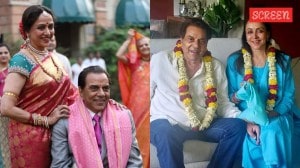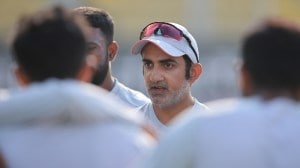IVF to save a rhino: Mumbai filmmaker’s docu-series wins at Cannes
Only two females of the northern white rhino species had survived after decades of poaching, and both couldn’t conceive or carry their pregnancy to term
 Mayurica Biswas at the Ol Pejeta Conservancy in Kenya
Mayurica Biswas at the Ol Pejeta Conservancy in KenyaWHILE OTT watchers were smitten by direwolves on Game of Thrones and their de-extinction was underway, a few more species were in various stages of conservation, or being brought back from their vanishing turns.
Indian documentary maker Mayurica Biswas recalls keenly following the drama unfolding in Kenya, where scientists were trying to save the northern white rhinos from disappearing forever. The original surrogate rhino had passed away in a flood, and a similar — but not the same — southern white rhino was inseminated by the German team in what was essentially science leaping into the unknowns.
 Mayurica Biswas with the team during the LA leg of the filming
Mayurica Biswas with the team during the LA leg of the filming
The Mumbai-based director’s docu-series, The Resurrection Quest, which followed a bunch of such efforts at animal cloning, gene editing, IVF tech and even the Chinese melancholic trend to clone pet dogs, has landed the prestigious Gold Dolphin (for a science, tech, innovation-related film) at the 16th Cannes Corporate Media and TV Awards held last week.
A former journalist who has been at Storyteller Films for a decade, Biswas had found herself reaching out to scientific teams that were engaged in all sorts of scientific efforts to bring back animals on the edge of extinction, from the wooly mammoth to the dodo. The rhino IVF was one of the many engaging tales captured in the four-part series.
 Mayurica Biswas hold the bone of an over 15,000-year-old mammoth at a place known as the graveyard of extinct animals
Mayurica Biswas hold the bone of an over 15,000-year-old mammoth at a place known as the graveyard of extinct animals
Only two females of the northern white rhino species had survived after decades of poaching, and both couldn’t conceive or carry their pregnancy to term. The fear of the species going extinct was real, and 30-odd embryos had been frozen over the years. “But the original surrogate passed away in the floods. The postmortem had revealed a tiny baby foetus — so she had managed to conceive. The German team then knew it was conceptually working. But you can’t freeze rhino eggs, and we were dealing with a 2,500-kg animal that couldn’t be carted around. So a southern white rhino surrogate was brought in,” she says, talking about what is one of the highlights of the documentary.
The makers of the docu-series, commissioned by Singapore’s CNA, makers consciously chose not to lend the visuals a “god-like voiceover”, allowing scientists and climate change experts working in the timebomb of a thawing permafrost to voice their views.
 The team filming inside a permafrost ice cave
The team filming inside a permafrost ice cave
But much before the teams set out to see how much of de-extinction was fact or myth, and the ethics of human interventions in these life-and-death situations, Biswas had been intrigued by a regular story of ivory trade. The trade, heavily restricted or banned, was was being replaced swiftly by a flourishing legal industry — the trafficking of wooly mammoth tusks from Siberian frozen fossils. “I realised it was much more than just tusk trade by mammoth tusk hunters — Chinese and Siberian. It was a story of finding tissue samples that would give you gene edited elephants that withstand Arctic conditions essentially,” she explains.
But the whole juggernaut is moving fast, she notes. “They are looking at turning skin cells into embryonic cells,” she says, stressing on the import of that technology. “Humans may not need males and females to procreate in the future with that depth of stem cell editing.”
 (From left) Sound recordist Prasenjit Das, executive producer and director Mayurica Biswas, director Radhika Chandrasekhar and director of photography Kartik Thapliyal at the Ol Pejeta Conservancy in Kenya
(From left) Sound recordist Prasenjit Das, executive producer and director Mayurica Biswas, director Radhika Chandrasekhar and director of photography Kartik Thapliyal at the Ol Pejeta Conservancy in Kenya
She filmed in underground ice caves, pet cloning labs, and the wildest of landscapes, across eight countries – Siberia, Kenya, Singapore, China, Czech Republic, Germany, UAE and USA.
But the moments that truly matters were the human emotions on the edge of this obsession — “A biologist obsessed with bringing back an extinct pigeon, a vet wracked with guilt over a pet’s death, a father-son duo racing against melting permafrost,” she explains in the director’s statement. “For them, resurrection wasn’t abstract — it was personal.”
Biswas says she was in no way blindly smitten by the science of it all.
“The Resurrection Quest does not offer simple answers. Instead it holds space for uncertainty, contradiction, and awe — for the complex emotional terrain of living in a world where we can edit genes but struggle to protect ecosystems,” she wrote.
Besides Biswas, creative director Radhika Chandrashekhar, series editor Tushar Ghogale and cinematographer Kartik Thapliyal made up the Indian crew for the Mumbai production house.







